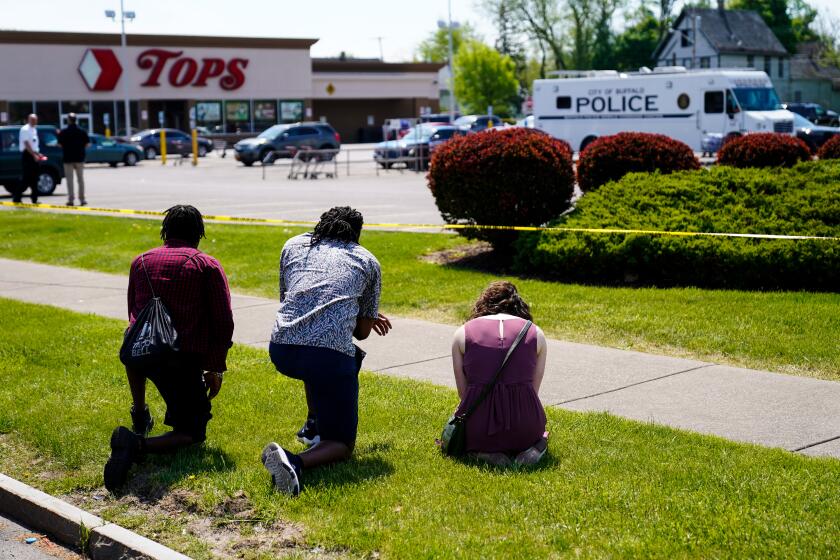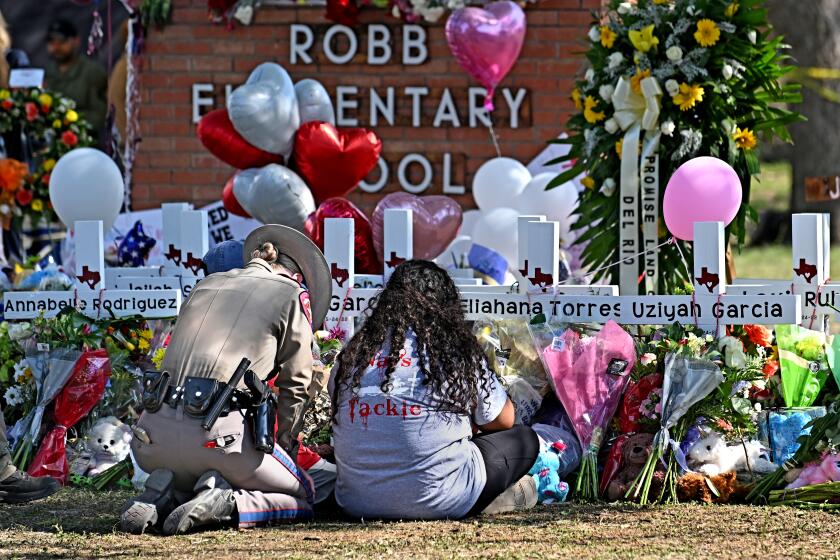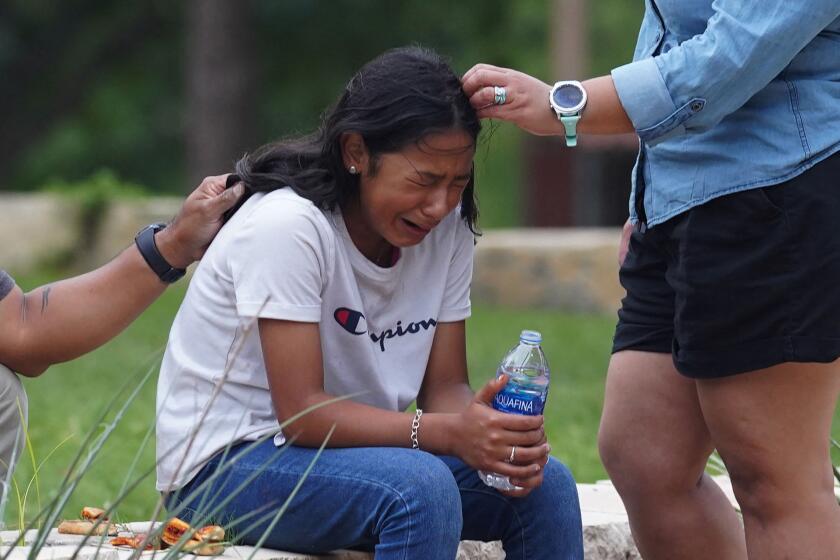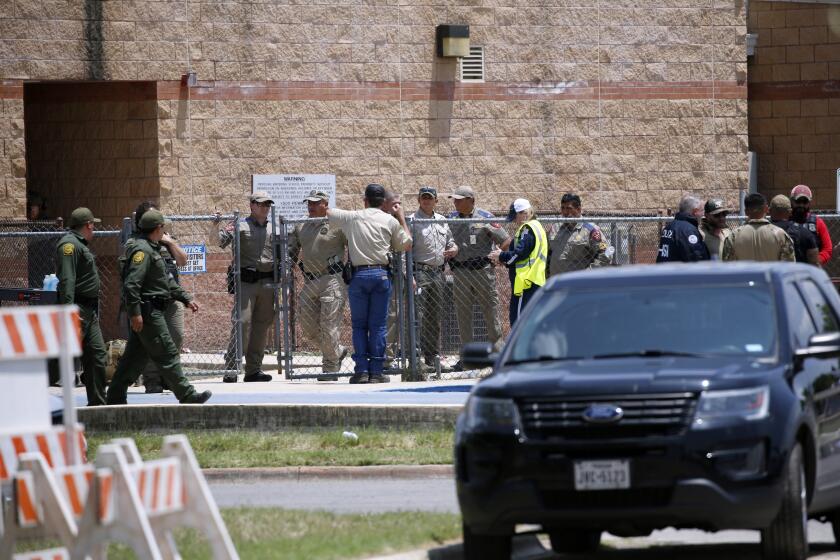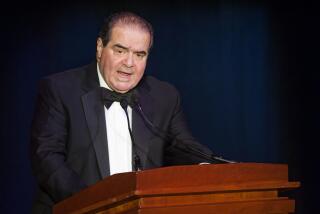Column: How many times has Biden said, ‘We’ve got to act’ on guns? What’s taking so long?

- Share via
After the last big horrendous, unimaginable, heartrending slaughter of innocents — that is to say just 10 days ago, when an 18-year-old allegedly shot and killed 10 Black people in a supermarket in Buffalo, N.Y. — distraught Americans wanted to know why it is permissible to ban people under 21 years of age from purchasing beer, yet it is unconstitutional to ban those same people from owning a gun.
Why, asked others, is it easier to procure a gun permit than a driver’s license? Why are there nearly 400 million guns in civilian hands?
Those questions feel even more urgent in the aftermath of Tuesday’s mass shooting in which another 18-year-old went on another wild killing spree, this time killing 19 elementary schoolchildren and two adults in Uvalde, Texas.
Opinion Columnist
Nicholas Goldberg
Nicholas Goldberg served 11 years as editor of the editorial page and is a former editor of the Op-Ed page and Sunday Opinion section.
Our gun laws are not just weak and insufficient. They are, to put it bluntly, suicidal. Yet year after year, we do little or nothing to change them. Instead we offer tears and prayers for the victims and then let the tragedies slip slowly from our minds as the days and weeks pass until the next nightmare inevitably occurs and the cycle begins again. “We have to act,” said President Biden Tuesday, just as he has said repeatedly in the past.
Sometimes we explain our inaction by blaming the enormously powerful National Rifle Assn. And certainly the NRA (which has faced its own travails in recent years) deserves a sizable portion of responsibility.
Or we blame the cynical, self-interested gun industry.
Or unconscionable Republican obstinance.
Or voter apathy, short attention spans and peripatetic news cycles.
The founders intended the 2nd Amendment to protect not individuals’ rights, but the rights of states to arm their own militias, without interference from the federal government.
All are partly to blame, no doubt. But one of the most serious obstacles to meaningful gun control laws dates back to the beginning of the republic. It’s the piece of historical bad luck that ties our hands: The founders of this country — those men in their powdered wigs, revered for their prescience and common sense — blindly and stupidly enshrined gun rights in the U.S. Constitution.
Well, perhaps stupidly is the wrong word. They didn’t actually mean for the 2nd Amendment to be what it has become. The founders presumably couldn’t have foreseen a violence-prone society more than 200 years in the future flooded with assault rifles and automatic weapons and ubiquitous handguns. They couldn’t have predicted copy-cat killings, elementary school shootings, domestic terrorism or senseless, random homicide.
Surely Thomas Jefferson and James Madison didn’t intend to protect the right of people like Salvador Ramos, Payton Gendron, Dylann Roof and Adam Lanza to massacre innocent people with deadly weapons of war.
A gunman killed 19 children and two adults at an elementary school in Uvalde, Texas, about 80 miles west of San Antonio, on May 24, 2022.
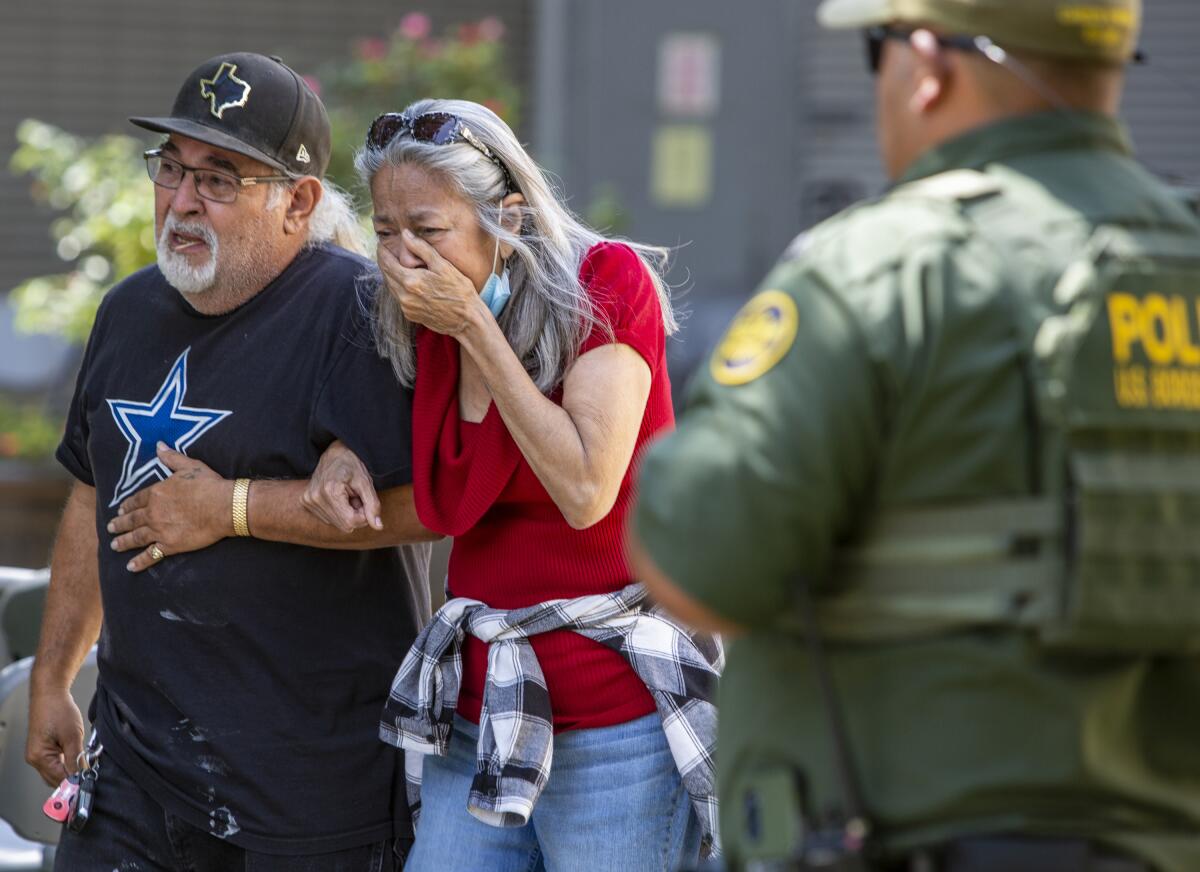
But regardless of their intentions, the 2nd Amendment they left us with is a jumbled piece of work. Historians and scholars and judges have spent years battling over whether it was actually meant to confer on each individual American a right to “keep and bear arms” that may not be abridged, or whether it was supposed to apply only in the context of the right to form self-defense militias.
In 2008, the U.S. Supreme Court for the first time ruled that the 2nd Amendment did in fact protect every American’s individual gun rights, immediately raising new impediments for states hoping to pass effective gun control laws. This year, the court seems ready to further expand gun rights in a case from New York involving the right to carry firearms outside the home.
The court is poised to do so even though more than half of Americans support stricter gun laws.
And even though the death toll is continuing to rise.
In a politically healthy society, the obvious path to a solution would be to amend the Constitution.
Recent mass shootings have spurred new calls for gun regulations. Experts say the opposite is happening.
After all, if we could just clarify what we want, we could more easily enact the laws we need. We wouldn’t have to rely on a conservative court’s interpretation of what a bunch of 18th century men would have thought about our 21st century problem.
If we could amend the Constitution, we could make it clear that 2nd Amendment rights are not absolute. Or that they do not preclude reasonable but effective restrictions. Or we could repeal the amendment altogether.
But, unfortunately, amending the Constitution is not a realistic option.
More than 11,000 amendments have been proposed since 1789, but only 27 have been enacted. Since 1971, only one constitutional amendment has been approved, a relatively insignificant one at that.
To be enacted, a constitutional amendment usually must be approved by a vote of two-thirds of both houses of Congress. Then it must be ratified by three-fourths of the states.
Some political scholars say it is harder to enact a constitutional amendment in the U.S. than anywhere else. One scholar has questioned whether the U.S. will ever pass a constitutional amendment again.
It’s tough even in calm times. But the idea that the United States could today pass a constitutional amendment on a subject as divisive as guns in a period of such extraordinarily high polarization and partisan division is laughable.
Texas school shooting: How to help kids get through unspeakable horror
So it’s back to the uphill battle for incremental change — for closing gun show loopholes and tightening background checks, for haggling over assault weapons bans and banning “ghost guns” and fighting to remove weapons from people deemed at risk of committing violent acts.
Back to tinkering around the edges of a catastrophic public health and safety epidemic.
Yes, we have to act. That much is clear.
But history suggests we won’t and can’t, that we’ll be right back here again in a matter of days, weeks or months, offering our tears and prayers for the dead, and few real solutions.
More to Read
A cure for the common opinion
Get thought-provoking perspectives with our weekly newsletter.
You may occasionally receive promotional content from the Los Angeles Times.

